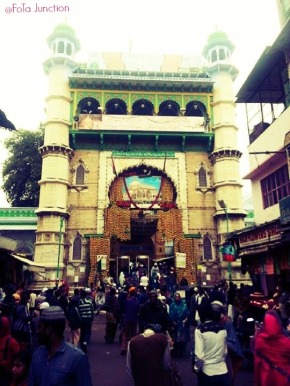This is the return leg of our lovely trip to Jaipur. And as is the rule with my co-pax and chief trip planner – my brother dearest – we are not returning by the route we went by. Co-pax says, “Return journeys are always boring and negative. They tire you more, so I like to return by a different route. It makes the return as exciting as the onward journey.” Point taken sire!
So while we went to Jaipur from Bhopal via Kota, for the return we are taking the Ajmer-Puskar-Chittorgarh-Indore route. After soaking in the morning energy of Nahargarh Fort and taking in some filmi gyaan (some scenes of Rang De Basanti were shot there) we zoom towards our next stop – Ajmer. And we are headed towards the most famous place in Ajmer – The world famous Ajmer Sharif Dargah or Dargah Sharif. The shrine of sufi saint Hazrat Khawaja Muinuddin Chishti.

The 136 kms stretch was a smooth drive with my co-pax as usual not believing in much breaks. The break we took was straight at the parking at Ajmer Sharif. Once you enter Ajmer all the serenity of the highway is gone and the hustle of an Indian small town takes over. The most entertaining sight as a co-passanger and the most harrowing one as a driver being the utter chaos on the narrow roads with no traffic rules holding ground. Ajmer town is no different. As we head towards the dargah looking for a parking nearest to the dargah, the roads are as crowded as it would be in any Indian town with a religious shrine at its centre. The dargah is Ajmer’s passport to the world, it’s identity symbol and the area around the dargah shows how much the dargah means to Ajmer. Every shop around the area is about the dargah, only. The roads have humans, cattle, auto-rickshas, motor bikes, cars, bicycles and hero-puchs, coexisting. That’s the beauty of India.
Parking renting out seems like a big business around the dargah and the USP of the service is the closer your parking space is to the dargah, the better. Making India Lazy since forever 😀
We finally found a parking space pretty near the dargah, though the kind of looks my brother gave the parking guy, I could figure out he was wondering if he’ll find the car intact when we return or not! Ajmer too, like countless pilgrimage places in India, seems to thrive on the business of faith and religion. And like all those places, evokes a sense of distrust. Maybe it is the crowd or the general business attitude but as a traveller that is the first feeling you get. Atleast that was the feeling I got till I got out of the parking into the lane leading to the dargah sharif. And what a view…
 The lanes were moderately filled with people moving about – coming and going to the dargah, locals shuttling between the shops on both sides. Both the sides of the lane were packed with shops selling things you could buy and take to the dargah or buy and take home as a memoir. And at the end of the lane stood the majestic Dargah Sharif. Entrance decked with flowers, welcoming us in its embrace. Trust me when I say this, the trust issues vanished for a while.
The lanes were moderately filled with people moving about – coming and going to the dargah, locals shuttling between the shops on both sides. Both the sides of the lane were packed with shops selling things you could buy and take to the dargah or buy and take home as a memoir. And at the end of the lane stood the majestic Dargah Sharif. Entrance decked with flowers, welcoming us in its embrace. Trust me when I say this, the trust issues vanished for a while.
One thing that caught my attention though, in all the crowd and chaos, were the sevanthi flowers in the shops selling items that can be taken inside the dargah, the entrance of the dargah was also decked with them and even the insides of the shrine was decked with them. Call me ill-informed, I have always associated the flower with the religion of Hinduism. Maybe because I have always seen the flower being used in Hindu pujas, temples, rituals etc. Mogra flower, yes I can associate with Islam but Sevanthi…that was a never, till my first day at Dargah Sharif!
As we took the stairs to enter the shrine there were people standing on the stairs sprinkling rose water on the people entering the shrine. A little fear poked its head up in my heart. “What if they ask me my religion and don’t allow me inside.“
Though nothing like that happened. Or even happens. Ajmer Dargah is said to receive more believers of other religions than Islam. Khawajaji ke darbaar mey sab ka swaagat hota hai.
We went in taking in the ambience of faith, the cool of the marble flooring and sevanthi flowers breaking the religious illusions in my mind with the intoxicating smell of faith, flowers and incense sticks. Another of my myth was about to break in there…

We had decided not to go inside the dargah, as in where the actual shrine is, as we didn’t have the luxury of time and also because neither of us are great pilgrims. We are travellers. We travel to take in the spirit of the place. For us this visit to Ajmer was more about witnessing the faith and taking in the positivity of the place than our own faith in bowing to the sufi saint.
As, we loitered around inside the shrine another bafflement caught me. This!
As a Hindu who visits temples at times, the manat ka dhaga (wish thread), is something that I have seen being tied around, a lot. Temple grills, trees, gates…every place where a thread can be accommodated, you would find one. Proof of how needy humans are and how bored our gods would be listening to all these wants! And I saw a similar sight in this sufi saint’s shrine. The walls are covered with the wish threads. The red ones. The ones I had always seen in hindu temples. And I could not believe what I was seeing! If I would have been blindfolded and brought in here, I could have called this place a temple – with the sevanti flower garlands, wish threads, incense stick smell. The only visible difference I could spot was a few skull caps in the crowd.
After spending some more time taking in the smell and sights of one of the most famous dargahs in India, we stepped outside. Dargah Sharif had shaken out some of my ignorant beliefs about the two largest religions of my country and I was leaving the steps of Khwajaji with a question, “And we fight in the name of religion? Two religions which are so similar even in symbolisms.” We walked back in to where we had parked the car, a bit more trusting than the beings who had walked out. We paid the parking fees and headed out to our next destination – to the only Brahma temple in India. To Puskar. Same district. Different religion. Or will I find similar symbolisms?
As we head out of Ajmer, towards Pushkar there is a lovely artificial lake on the left hand side. If you have time, do stop by, it looked serene and peaceful. We could not. We were in hurry to meet the creator, not literally though 😉

What a lovely description 🙂
I like the idea of choosing a different route.
Good luck for the challenge.
LikeLiked by 1 person
Thank you Simran. Best to you too.
LikeLike
Hi Reshma, I found your blog through the A to Z Challenge! What a lovely shrine! And your descriptions are wonderful – I feel like I am there! India is definitely on my list of places I want to travel someday.
I agree with your feelings on the similarities between/amongst religions. There is a lot more similarities that many people think!
And I’m looking forward to the rest of your journey home!
LuAnn (approx #374 on the list) @ Back Porchervations.
(and one of co-host AJ Lauer’s #wHooligans)
LikeLiked by 1 person
Hey thank you so much for your inspiring words. It’s gonna push me to write more 🙂
You’ll have more from India here. Keep visiting. Till you can visit we’ll take you on virtual tours.
LikeLike
well what muslims pray to one god where as hindus have several gods what really made you feel that it was same like a temple.
LikeLike
Some of the symbolisms.
LikeLike